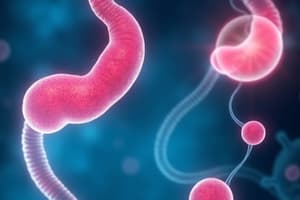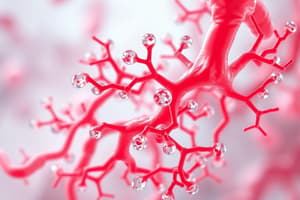Podcast
Questions and Answers
What is the primary role of carbohydrates in biological systems?
What is the primary role of carbohydrates in biological systems?
- To serve exclusively as a structural component
- To provide significant energy and serve various metabolic functions (correct)
- To be the main component of genetic material
- To act solely as enzymes in biochemical reactions
Which of the following correctly classifies carbohydrates based on their hydrolysis products?
Which of the following correctly classifies carbohydrates based on their hydrolysis products?
- Glycogen, Starch, Cellulose, Oligosaccharides
- Amino acids, Nucleotides, Monosaccharides, Polysaccharides
- Dipeptides, Polypeptides, Monosaccharides, Disaccharides
- Monosaccharides, Disaccharides, Oligosaccharides, Polysaccharides (correct)
What is the most significant carbohydrate and its main storage forms in plants and animals?
What is the most significant carbohydrate and its main storage forms in plants and animals?
- Glucose; stored as starch in plants and glycogen in animals (correct)
- Fructose; stored as sucrose
- Ribose; stored as nucleic acids
- Galactose; stored as cellulose
Which carbohydrate classification contains sugar units ranging from 3 to 10 monosaccharides?
Which carbohydrate classification contains sugar units ranging from 3 to 10 monosaccharides?
What is one of the functions of carbohydrates related to cellular communication?
What is one of the functions of carbohydrates related to cellular communication?
Which sugar is primarily considered the main energy source for mammals?
Which sugar is primarily considered the main energy source for mammals?
What type of reaction joins two monosaccharides in the formation of disaccharides?
What type of reaction joins two monosaccharides in the formation of disaccharides?
Which polysaccharide primarily functions as a storage form of glucose in plants?
Which polysaccharide primarily functions as a storage form of glucose in plants?
Which of the following sugars is a component of nucleic acids?
Which of the following sugars is a component of nucleic acids?
Glycosaminoglycans are primarily composed of which types of sugars?
Glycosaminoglycans are primarily composed of which types of sugars?
Flashcards are hidden until you start studying
Study Notes
Tetroses and Pentoses
- Erythrose 4-phosphate is produced during glucose oxidation in cells.
- D-ribose is integral to nucleosides, nucleotides, and RNA.
- Deoxyribose is crucial for DNA structure.
Glucose
- Primary sugar in blood; found in all animal and plant cells, honey, and fruits.
- Serves as the main energy source for mammals.
- Other sugars are converted to glucose in the liver.
- Precursor for synthesizing carbohydrates, including:
- Glycogen for energy storage
- Ribose and deoxyribose in nucleic acids
- Galactose in milk's lactose
- Glycolipids
- Glycoproteins and proteoglycans in protein complexes
Fructose and Galactose
- Fructose is present in honey, fruits, and semen; a component of sucrose and inulin.
- D-galactose is part of lactose found in milk and is present in glycosaminoglycans, glycolipids, and glycoproteins.
Disaccharides
- Formed by the condensation reaction of two monosaccharides, releasing water and creating glycosidic linkages.
- Sucrose is an example of a common disaccharide (table sugar).
Polysaccharides
- Serve storage and structural functions in biological systems.
- Starch is a glucose polymer consisting of amylose (20–30%) and amylopectin (70–80%).
- Excess glucose is stored as starch.
- Glycogen is another important polysaccharide with branched structures.
Glycosaminoglycans
- Complex carbohydrates made from amino sugars and uronic acids; part of structural frameworks in tissues.
General Properties of Carbohydrates
- Composed of carbon, hydrogen, and oxygen, following the formula Cn(H2O)n.
- Commonly referred to as hydrates of carbon.
- Most abundant biological molecules; critical for various functions:
- Energy source and storage
- Cell membrane components enabling intercellular communication
- Synthesis materials for complex biomolecules
- Provide fibrous structural materials for organisms
- Involved in fertilization, development, blood clotting, and immune responses.
Classification of Carbohydrates
- Monosaccharides: Single sugar units, general formula (CH2O)n.
- Disaccharides: Composed of two monosaccharide units.
- Oligosaccharides: Contain 3 to 10 monosaccharide units.
- Polysaccharides: Contain more than 10 monosaccharide units.
Monosaccharide Derivatives
- Derivatives include sugar phosphates, deoxy and amino sugars, sugar alcohols, and sugar acids.
- Sugar acids: Carboxylic acids from aldoses; examples include gluconic acid and ascorbic acid (Vitamin C), essential for several biochemical processes.
- Sugar alcohols: The carbonyl group is reduced to an alcohol group. Examples include sorbitol (linked to diabetic complications), mannitol (used in medical treatments), ribitol (component of vitamin B2), and glycerol (found in lipids).
- Deoxy sugars: Hydroxyl group replaced by hydrogen. Notable examples are 2-deoxy ribose (in DNA) and L-fucose (present in glycoproteins).
- Amino sugars: An amino group replaces the hydroxyl group on monosaccharides.
Studying That Suits You
Use AI to generate personalized quizzes and flashcards to suit your learning preferences.




